Academic Plagiarism and Its Relevance
VerifiedAdded on 2023/01/03
|6
|1362
|50
AI Summary
This report discusses academic plagiarism, including its definition, types, and relevance in a business context. It also provides tips on how to avoid plagiarism and improve academic writing and professionalism.
Contribute Materials
Your contribution can guide someone’s learning journey. Share your
documents today.
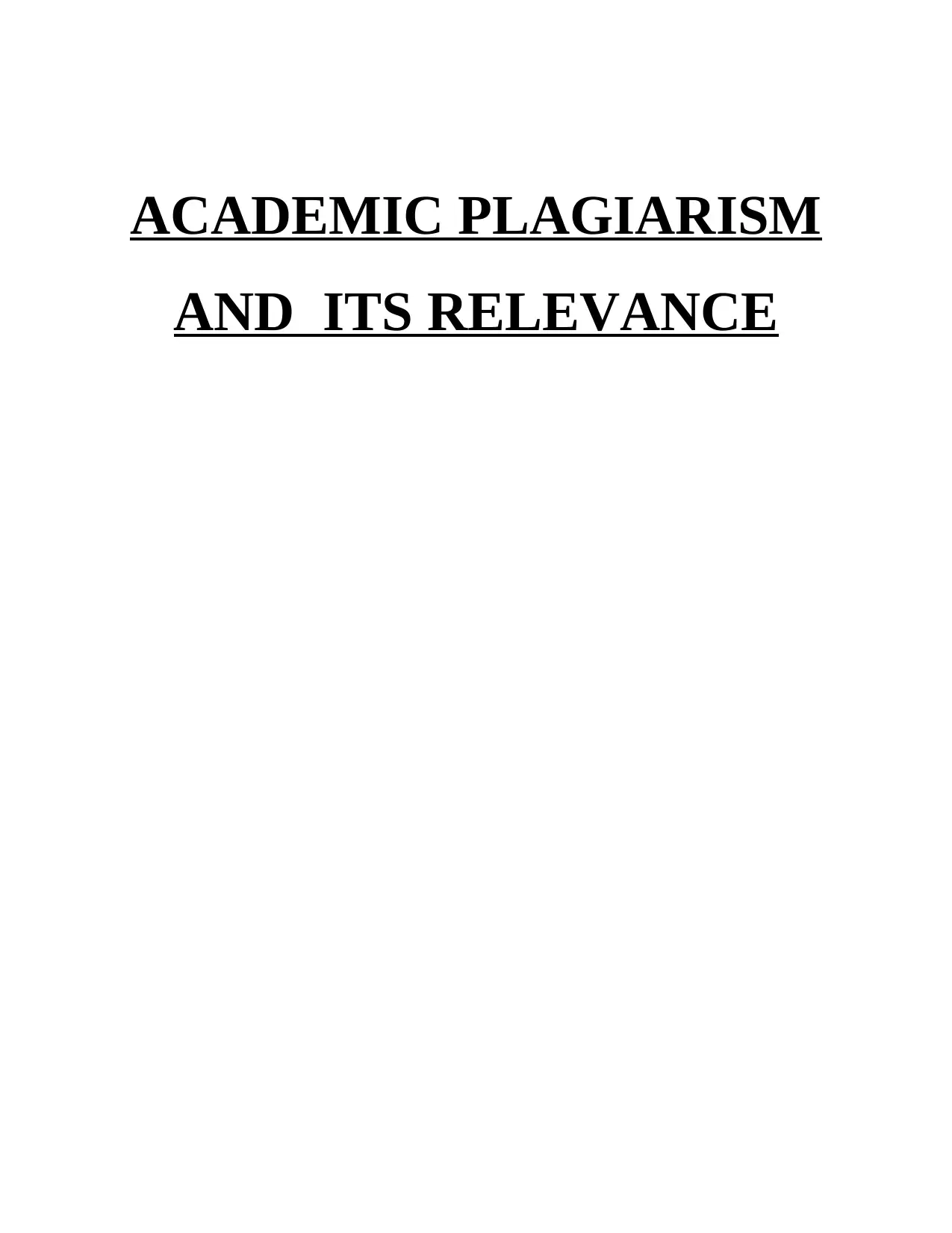
ACADEMIC PLAGIARISM
AND ITS RELEVANCE
AND ITS RELEVANCE
Secure Best Marks with AI Grader
Need help grading? Try our AI Grader for instant feedback on your assignments.
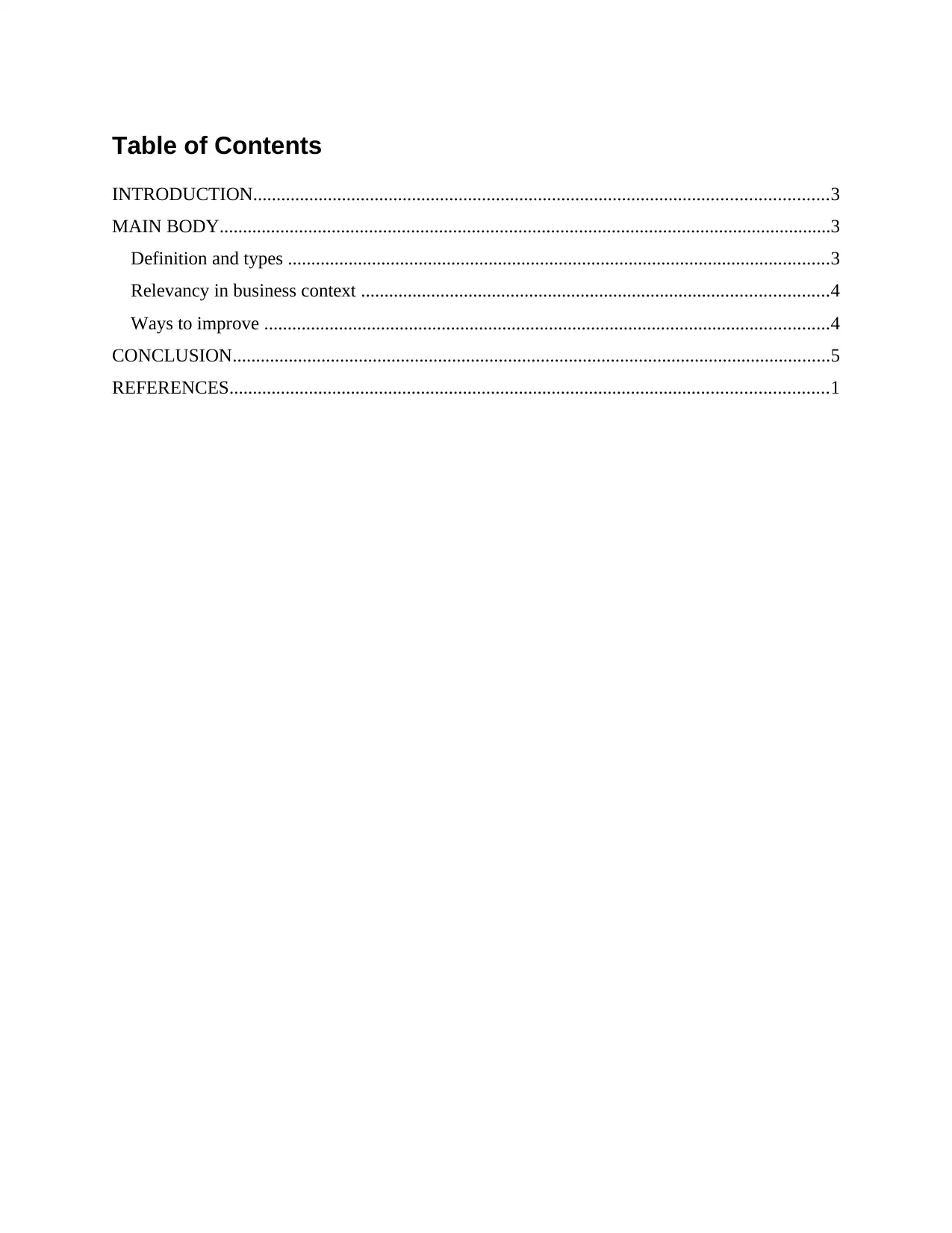
Table of Contents
INTRODUCTION...........................................................................................................................3
MAIN BODY...................................................................................................................................3
Definition and types ....................................................................................................................3
Relevancy in business context ....................................................................................................4
Ways to improve .........................................................................................................................4
CONCLUSION................................................................................................................................5
REFERENCES................................................................................................................................1
INTRODUCTION...........................................................................................................................3
MAIN BODY...................................................................................................................................3
Definition and types ....................................................................................................................3
Relevancy in business context ....................................................................................................4
Ways to improve .........................................................................................................................4
CONCLUSION................................................................................................................................5
REFERENCES................................................................................................................................1
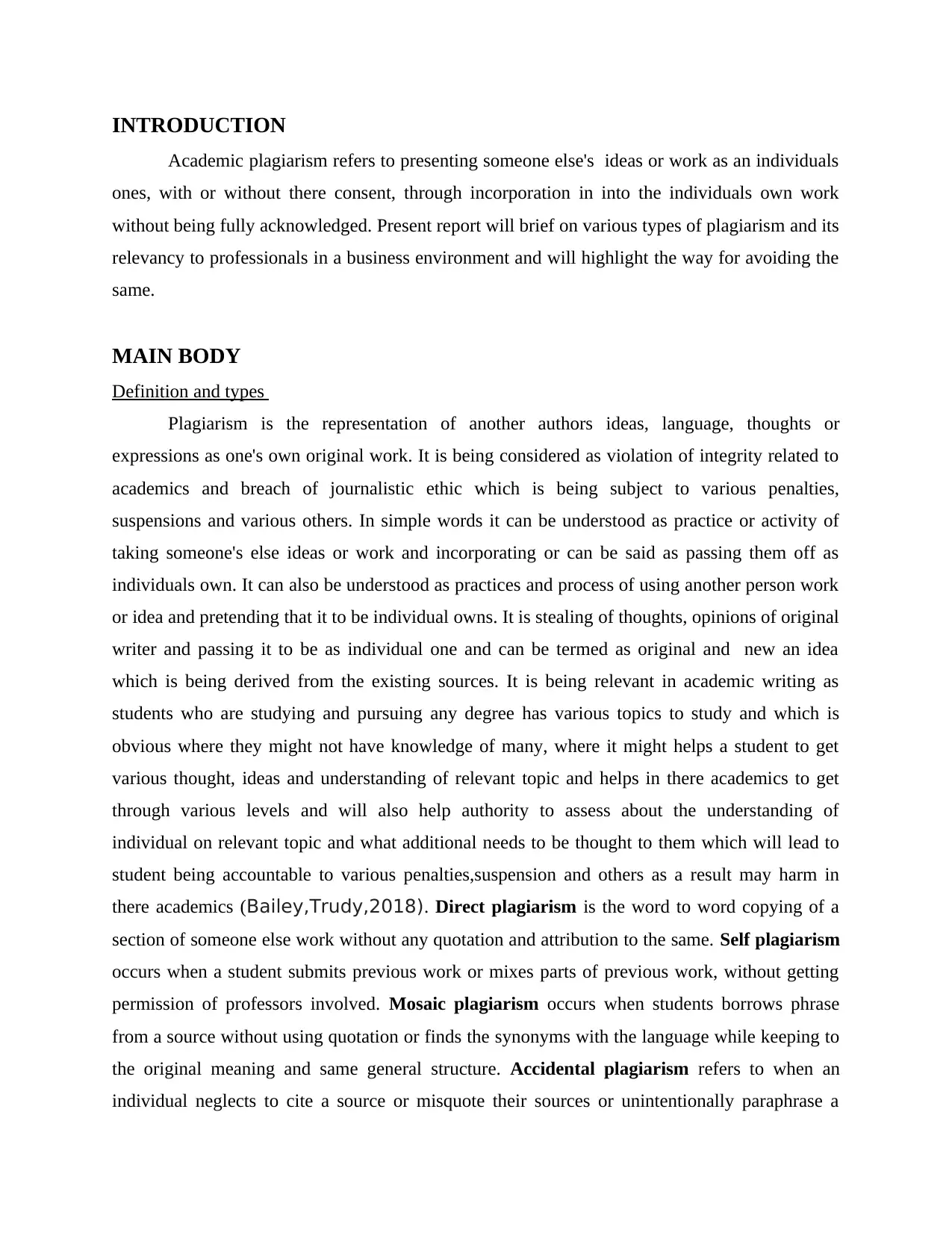
INTRODUCTION
Academic plagiarism refers to presenting someone else's ideas or work as an individuals
ones, with or without there consent, through incorporation in into the individuals own work
without being fully acknowledged. Present report will brief on various types of plagiarism and its
relevancy to professionals in a business environment and will highlight the way for avoiding the
same.
MAIN BODY
Definition and types
Plagiarism is the representation of another authors ideas, language, thoughts or
expressions as one's own original work. It is being considered as violation of integrity related to
academics and breach of journalistic ethic which is being subject to various penalties,
suspensions and various others. In simple words it can be understood as practice or activity of
taking someone's else ideas or work and incorporating or can be said as passing them off as
individuals own. It can also be understood as practices and process of using another person work
or idea and pretending that it to be individual owns. It is stealing of thoughts, opinions of original
writer and passing it to be as individual one and can be termed as original and new an idea
which is being derived from the existing sources. It is being relevant in academic writing as
students who are studying and pursuing any degree has various topics to study and which is
obvious where they might not have knowledge of many, where it might helps a student to get
various thought, ideas and understanding of relevant topic and helps in there academics to get
through various levels and will also help authority to assess about the understanding of
individual on relevant topic and what additional needs to be thought to them which will lead to
student being accountable to various penalties,suspension and others as a result may harm in
there academics (Bailey,Trudy,2018). Direct plagiarism is the word to word copying of a
section of someone else work without any quotation and attribution to the same. Self plagiarism
occurs when a student submits previous work or mixes parts of previous work, without getting
permission of professors involved. Mosaic plagiarism occurs when students borrows phrase
from a source without using quotation or finds the synonyms with the language while keeping to
the original meaning and same general structure. Accidental plagiarism refers to when an
individual neglects to cite a source or misquote their sources or unintentionally paraphrase a
Academic plagiarism refers to presenting someone else's ideas or work as an individuals
ones, with or without there consent, through incorporation in into the individuals own work
without being fully acknowledged. Present report will brief on various types of plagiarism and its
relevancy to professionals in a business environment and will highlight the way for avoiding the
same.
MAIN BODY
Definition and types
Plagiarism is the representation of another authors ideas, language, thoughts or
expressions as one's own original work. It is being considered as violation of integrity related to
academics and breach of journalistic ethic which is being subject to various penalties,
suspensions and various others. In simple words it can be understood as practice or activity of
taking someone's else ideas or work and incorporating or can be said as passing them off as
individuals own. It can also be understood as practices and process of using another person work
or idea and pretending that it to be individual owns. It is stealing of thoughts, opinions of original
writer and passing it to be as individual one and can be termed as original and new an idea
which is being derived from the existing sources. It is being relevant in academic writing as
students who are studying and pursuing any degree has various topics to study and which is
obvious where they might not have knowledge of many, where it might helps a student to get
various thought, ideas and understanding of relevant topic and helps in there academics to get
through various levels and will also help authority to assess about the understanding of
individual on relevant topic and what additional needs to be thought to them which will lead to
student being accountable to various penalties,suspension and others as a result may harm in
there academics (Bailey,Trudy,2018). Direct plagiarism is the word to word copying of a
section of someone else work without any quotation and attribution to the same. Self plagiarism
occurs when a student submits previous work or mixes parts of previous work, without getting
permission of professors involved. Mosaic plagiarism occurs when students borrows phrase
from a source without using quotation or finds the synonyms with the language while keeping to
the original meaning and same general structure. Accidental plagiarism refers to when an
individual neglects to cite a source or misquote their sources or unintentionally paraphrase a
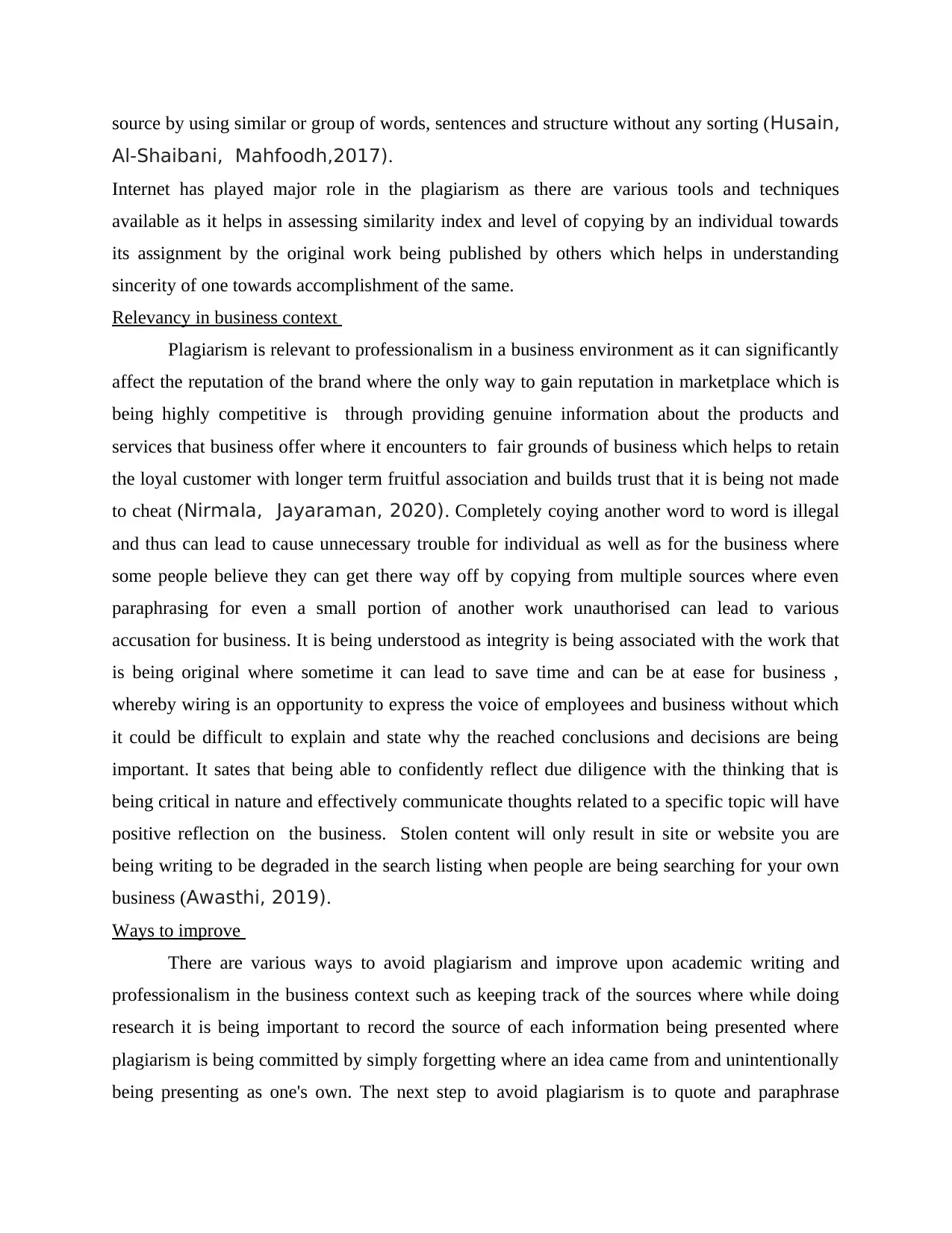
source by using similar or group of words, sentences and structure without any sorting (Husain,
Al-Shaibani, Mahfoodh,2017).
Internet has played major role in the plagiarism as there are various tools and techniques
available as it helps in assessing similarity index and level of copying by an individual towards
its assignment by the original work being published by others which helps in understanding
sincerity of one towards accomplishment of the same.
Relevancy in business context
Plagiarism is relevant to professionalism in a business environment as it can significantly
affect the reputation of the brand where the only way to gain reputation in marketplace which is
being highly competitive is through providing genuine information about the products and
services that business offer where it encounters to fair grounds of business which helps to retain
the loyal customer with longer term fruitful association and builds trust that it is being not made
to cheat (Nirmala, Jayaraman, 2020). Completely coying another word to word is illegal
and thus can lead to cause unnecessary trouble for individual as well as for the business where
some people believe they can get there way off by copying from multiple sources where even
paraphrasing for even a small portion of another work unauthorised can lead to various
accusation for business. It is being understood as integrity is being associated with the work that
is being original where sometime it can lead to save time and can be at ease for business ,
whereby wiring is an opportunity to express the voice of employees and business without which
it could be difficult to explain and state why the reached conclusions and decisions are being
important. It sates that being able to confidently reflect due diligence with the thinking that is
being critical in nature and effectively communicate thoughts related to a specific topic will have
positive reflection on the business. Stolen content will only result in site or website you are
being writing to be degraded in the search listing when people are being searching for your own
business (Awasthi, 2019).
Ways to improve
There are various ways to avoid plagiarism and improve upon academic writing and
professionalism in the business context such as keeping track of the sources where while doing
research it is being important to record the source of each information being presented where
plagiarism is being committed by simply forgetting where an idea came from and unintentionally
being presenting as one's own. The next step to avoid plagiarism is to quote and paraphrase
Al-Shaibani, Mahfoodh,2017).
Internet has played major role in the plagiarism as there are various tools and techniques
available as it helps in assessing similarity index and level of copying by an individual towards
its assignment by the original work being published by others which helps in understanding
sincerity of one towards accomplishment of the same.
Relevancy in business context
Plagiarism is relevant to professionalism in a business environment as it can significantly
affect the reputation of the brand where the only way to gain reputation in marketplace which is
being highly competitive is through providing genuine information about the products and
services that business offer where it encounters to fair grounds of business which helps to retain
the loyal customer with longer term fruitful association and builds trust that it is being not made
to cheat (Nirmala, Jayaraman, 2020). Completely coying another word to word is illegal
and thus can lead to cause unnecessary trouble for individual as well as for the business where
some people believe they can get there way off by copying from multiple sources where even
paraphrasing for even a small portion of another work unauthorised can lead to various
accusation for business. It is being understood as integrity is being associated with the work that
is being original where sometime it can lead to save time and can be at ease for business ,
whereby wiring is an opportunity to express the voice of employees and business without which
it could be difficult to explain and state why the reached conclusions and decisions are being
important. It sates that being able to confidently reflect due diligence with the thinking that is
being critical in nature and effectively communicate thoughts related to a specific topic will have
positive reflection on the business. Stolen content will only result in site or website you are
being writing to be degraded in the search listing when people are being searching for your own
business (Awasthi, 2019).
Ways to improve
There are various ways to avoid plagiarism and improve upon academic writing and
professionalism in the business context such as keeping track of the sources where while doing
research it is being important to record the source of each information being presented where
plagiarism is being committed by simply forgetting where an idea came from and unintentionally
being presenting as one's own. The next step to avoid plagiarism is to quote and paraphrase
Secure Best Marks with AI Grader
Need help grading? Try our AI Grader for instant feedback on your assignments.

where quoting is means of copying information word to word where the copied text must be
introduced in one own words and to enclosed in the quotation mark with the correct attribution to
the author being original (Van Lam,Filipi, 2017). Paraphrasing refers to the means of using
individual own words to explain something related with the source which allows getting most
important and valuable information. The next step is to cite the sources where every time an
individual quote or paraphrase it needs to include an in text citation or can be said as footnote
citation that helps in identifying original author which also includes page number and various
publication years (Vani,Gupta,2018). The next step to avoid plagiarism is to use a plagiarism
checker which helps in scanning document, compares it with the huge database of websites,
several publications which helps academician and business professional to highlights passages
that are similar with the other texts whereby changes can be made and accounts to reduction in
copied text by writing in individual own languages.
CONCLUSION
From the above report it is being understood as what is being meant by plagiarism and
why it is being relevant in the academic writing where it has identified and described various
types of plagiarism and the role of internet. It is also understood why it is being relevant to
professionals in business context and also suggested various ways to avoid the same.
introduced in one own words and to enclosed in the quotation mark with the correct attribution to
the author being original (Van Lam,Filipi, 2017). Paraphrasing refers to the means of using
individual own words to explain something related with the source which allows getting most
important and valuable information. The next step is to cite the sources where every time an
individual quote or paraphrase it needs to include an in text citation or can be said as footnote
citation that helps in identifying original author which also includes page number and various
publication years (Vani,Gupta,2018). The next step to avoid plagiarism is to use a plagiarism
checker which helps in scanning document, compares it with the huge database of websites,
several publications which helps academician and business professional to highlights passages
that are similar with the other texts whereby changes can be made and accounts to reduction in
copied text by writing in individual own languages.
CONCLUSION
From the above report it is being understood as what is being meant by plagiarism and
why it is being relevant in the academic writing where it has identified and described various
types of plagiarism and the role of internet. It is also understood why it is being relevant to
professionals in business context and also suggested various ways to avoid the same.
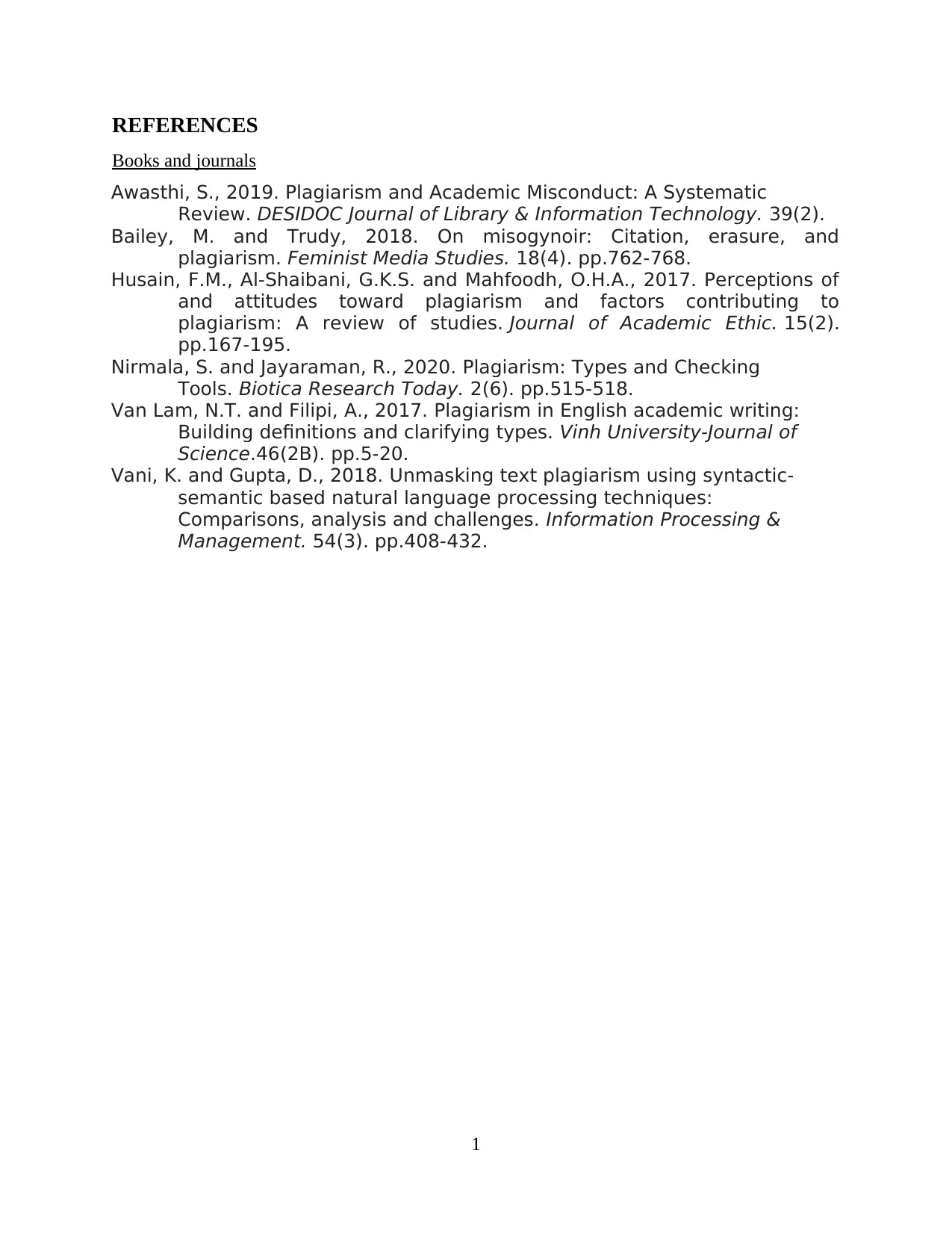
REFERENCES
Books and journals
Awasthi, S., 2019. Plagiarism and Academic Misconduct: A Systematic
Review. DESIDOC Journal of Library & Information Technology. 39(2).
Bailey, M. and Trudy, 2018. On misogynoir: Citation, erasure, and
plagiarism. Feminist Media Studies. 18(4). pp.762-768.
Husain, F.M., Al-Shaibani, G.K.S. and Mahfoodh, O.H.A., 2017. Perceptions of
and attitudes toward plagiarism and factors contributing to
plagiarism: A review of studies. Journal of Academic Ethic. 15(2).
pp.167-195.
Nirmala, S. and Jayaraman, R., 2020. Plagiarism: Types and Checking
Tools. Biotica Research Today. 2(6). pp.515-518.
Van Lam, N.T. and Filipi, A., 2017. Plagiarism in English academic writing:
Building definitions and clarifying types. Vinh University-Journal of
Science.46(2B). pp.5-20.
Vani, K. and Gupta, D., 2018. Unmasking text plagiarism using syntactic-
semantic based natural language processing techniques:
Comparisons, analysis and challenges. Information Processing &
Management. 54(3). pp.408-432.
1
Books and journals
Awasthi, S., 2019. Plagiarism and Academic Misconduct: A Systematic
Review. DESIDOC Journal of Library & Information Technology. 39(2).
Bailey, M. and Trudy, 2018. On misogynoir: Citation, erasure, and
plagiarism. Feminist Media Studies. 18(4). pp.762-768.
Husain, F.M., Al-Shaibani, G.K.S. and Mahfoodh, O.H.A., 2017. Perceptions of
and attitudes toward plagiarism and factors contributing to
plagiarism: A review of studies. Journal of Academic Ethic. 15(2).
pp.167-195.
Nirmala, S. and Jayaraman, R., 2020. Plagiarism: Types and Checking
Tools. Biotica Research Today. 2(6). pp.515-518.
Van Lam, N.T. and Filipi, A., 2017. Plagiarism in English academic writing:
Building definitions and clarifying types. Vinh University-Journal of
Science.46(2B). pp.5-20.
Vani, K. and Gupta, D., 2018. Unmasking text plagiarism using syntactic-
semantic based natural language processing techniques:
Comparisons, analysis and challenges. Information Processing &
Management. 54(3). pp.408-432.
1
1 out of 6
Related Documents
Your All-in-One AI-Powered Toolkit for Academic Success.
+13062052269
info@desklib.com
Available 24*7 on WhatsApp / Email
![[object Object]](/_next/static/media/star-bottom.7253800d.svg)
Unlock your academic potential
© 2024 | Zucol Services PVT LTD | All rights reserved.





